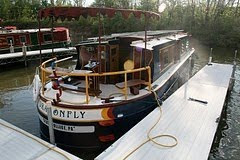 |
| Where We Stayed: Kewaunee, Wisconsin. We rose at dawn to see this tall ship docked across the harbor! |
Boaters always ask each other, “Where did you come from? and “How long you out for?”
When we say “The Erie Canal,” and “A whole year—we’re doing
the Great Loop,” we get confused
looks. That’s because out here, in
the Midwest, it’s trendy to do a “Great Circle” tour, which is a circumnavigation of one
of the Great Lakes.
But nope, our route is the Great LOOP. There’s no concise way to describe where
it takes you. I usually say, “The
Great Loop is the system of waterways that turns North America, east of the Mississippi,
into one enormous island.” Whew!
(If you have trouble picturing that, here’s a map.)
 |
| You can even join a club for Loopers! |
More variations on a theme: In the next leg of our route,
we’ll go down the Mississippi River to the Tennessee and Tombigbee waterways,
entering the Gulf at Mobile, Alabama. But some people stay on the Big Muddy all
the way to New Orleans.
There’s something about the trip that captures the
imagination. To travel so far in a boat, yet always be close to land. To see so much of North American
by boat.
The Loop has been described as “the longest inland water route in North America”—more than six thousand miles. Admittedly “inland” is a bit of a stretch, since you cruise the Gulf of Mexico and up the East Coast. But Loopers stay in the channel called the IntraCoastal Waterway, which is mostly (though not entirely) sheltered from the open ocean by chains of barrier islands.
The Loop has been described as “the longest inland water route in North America”—more than six thousand miles. Admittedly “inland” is a bit of a stretch, since you cruise the Gulf of Mexico and up the East Coast. But Loopers stay in the channel called the IntraCoastal Waterway, which is mostly (though not entirely) sheltered from the open ocean by chains of barrier islands.
We are hardly the first people to make this trip; by some
estimates a hundred to a hundred-and-fifty pleasure boats do the Loop each
year. This year we think it’s
more. It’s hard to get an exact
count because different people start at different times in different places;
for example, if you live in Florida you’d start there, in the winter. If you live in Virginia, you’d start
there in March. And not everyone
finishes the trip within a single year.
The most common way to cruise the loop is in a powerboat,
typically a cruiser or a trawler. Cruisers look like jumbo versions of the
typical powerboats you’d see on any lake, pulling waterskiers. Trawlers look more like miniature
tugboats, or lobster boats. In
general, cruisers can go a little faster than trawlers, but burn more fuel
doing so.
Of course you don’t have to do the Loop in a powerboat. One guy rowed around in an Adirondack
wherry—which is a boat just like our dinghy! Another guy is currently doing the loop in a 15-foot sailboat
hull, the Dalamar. Yup, I said sailboat HULL--no
sails—powered by a couple of tiny two-horsepower Honda engines.
According to boaters we met in Oswego, this is his retirement adventure--he told his niece it was gambling or boating so she went with the boating. Reportedly he’s living on Cheez Whiz and Pringles and his autopilot is a bungee cord around the tiller. We’d love to meet him.
According to boaters we met in Oswego, this is his retirement adventure--he told his niece it was gambling or boating so she went with the boating. Reportedly he’s living on Cheez Whiz and Pringles and his autopilot is a bungee cord around the tiller. We’d love to meet him.
Actually our trip may NOT be the first solar-powered circumnavigation
of the Great Loop. Back in Oswego,
we also met fellow loopers John and Nancy (pilots of the striking bright-red
Norwegian trawler, Valentine) who
thought they’d heard of a pontoon boat that made it last year with a canopy covered
by solar panels. We’d love to meet
them too.
We’re pretty sure our trip will be the “first
circumnavigation by canal boat.” And almost assuredly it’s the first circumnavigation by
solar-powered canal boat. But who
knows. Anyone got a Guinness Book
of World Records?
If you'd like to see what some other Great Loopers are doing, here's a website linking to a whole bunch of Looper blogs:
And hey, the website OFF-GRID.net picked up on our trip!





No comments:
Post a Comment